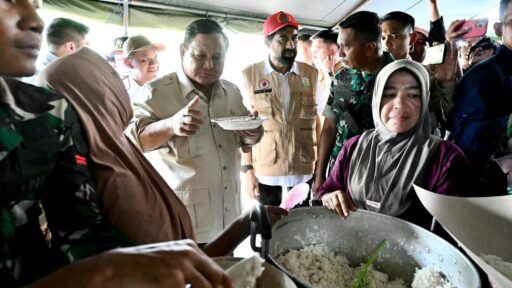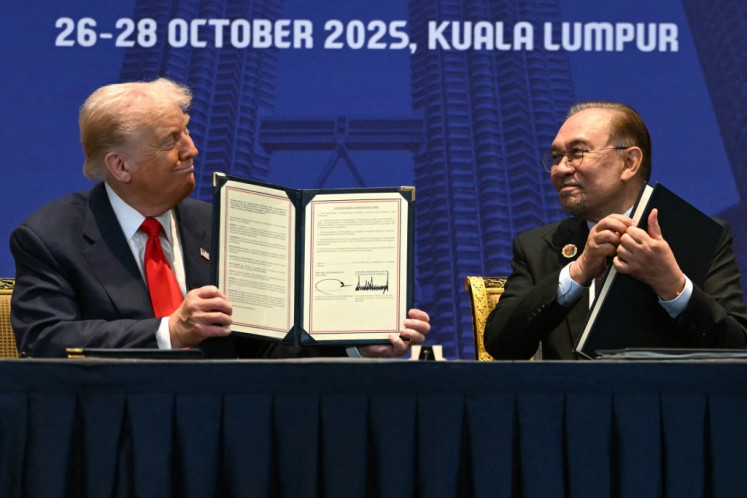Popular Reads
Top Results
Can't find what you're looking for?
View all search resultsPopular Reads
Top Results
Can't find what you're looking for?
View all search resultsLasiyo Syaifudin: Farming the smart way
JP/Slamet SusantoFarmers should not be poor, Lasiyo Syaifudin has decided
Change text size
Gift Premium Articles
to Anyone
JP/Slamet Susanto
Farmers should not be poor, Lasiyo Syaifudin has decided.
The 50-year-old Ponggok farmer — from Bambanglipuro, Bantul — has therefore made it his mission to tell his peers how to farm smart — while also applying local wisdom — by using biological material when planting crops or reducing dependence on chemical substances.
Lasiyo, who has rarely been at home in recent years, trains farmers on how to use biological fertilizers and plant, when he is not busy in the fields.
“I might get four invitations to train farming cooperatives in one month, and of course I will always choose to go,” said Lasiyo.
Lasiyo’s persistence and mobility have earned him a quite a reputation in the farming community.
“There is quite a bit of scorn and mockery. Understandably, the farmers have long been dependent on chemical substances and they find it difficult to accept change,” he said.
When this father of two served as the head of the combined Farmer’s Water User’s Association (P3A) in Bantul Regency, he became acutely aware of farmers’ challenges.
“Through the P3A, I became concerned about the fate of the farmers who are always marginalized and struggle with the high cost of agricultural fertilizers and medicines,” Lasiyo recalled.
Lasiyo knows it’s impossible to ask farmers to change their habits without providing evidence the new methods are worth it. Since 2004, he has run test trials of planting procedures using various types of plants.
In 2005, he started using a new way of planting rice called the system of rice intensification (SRI).
Seeds less than 15 days old are planted 2 to 3 centimeters deep, 25 centimeters from one another.
Seeds used normally tend to be 25-day-old and planted 5 centimeters from one another. The plants are normally between 10 and 25 centimeters apart and a few seeds are planted in each hole.
Based on test trials carried out by the Faculty of Agricultural Technology (FTP) at the Gadjah Mada University (UGM), the production of rice using the SRI system reaches 8 to 11.5 tons per hectare of dry grain harvested — more than the conventional system of production, which yields an average
of 6 tons of dry grain per hectare each harvest.
Through trials sponsored by PT Unilever, Lasiyo developed an effective soybean planting procedure, planting seeds 10 to 40 centimeters apart and yielding 2.5 tons of soybeans per hectare — more than double the yield achieved using the conventional method.
“I was the first farmer who successfully applied the SRI system. In 2007, I was invited to attend a training seminar in Jakarta on plants and their biological constitution,” recalled Lasiyo.
His biological pesticides consist of chilli juice to repel locusts, papaya juice as an adhesive, and mimba leaves soaked in water as an insect repellent.
Before introducing his products to other farmers, he first tests them in his own rice fields.
Although the quality of his produce doesn’t quite match that of rice cultivated using chemical
pesticides, his natural pesticides are much cheaper, costing only Rp 5,000 (US$0.50) per liter compared to hundreds of thousands of rupiah for chemical pesticides.
Biological pesticides work differently from chemical ones that immediately kill pests. “Farmers feel more comfortable using chemical pesticides because they can see pests die in front of them,” said Lasiyo.
With the help of the Agriculture Department of the Bantul subdistrict, Lasiyo received funds in 2009 to develop a production unit as well as establish an information service center and technology biological agency Puspita Hati (flower’s heart) in his village to make biological pesticides.
This activity initially involved 10 agricultural cooperatives, but only a few have survived. Every month, Puspita Hati produces hundreds of liters of biological pesticides, which are distributed to various farming cooperatives.
Lasiyo, along with Puspita Hati, now uses local micro-organisms instead of bio staters, which accelerate the process of making natural fertilizers. Local micro-organisms are made from coconut milk, leri (rice water), ash from kitchen stoves and sugar water.
The materials are then mixed with bacterial fertilizer (animal offal, rice field snails and bones) and soaked for two weeks. Every month, three to five tons can be produced.
“Using these local micro-organisms, compost manure can be turned into organic fertilizer within a month. If it is done without using micro-organisms, then the process takes more than three months,” said Lasiyo.
While Lasiyo’s methods have been proved cheaper and more effective, it’s still not that easy to change the mindset of farmers.
“Their pattern of dependence on conventional procedures is so strong that it takes a long time and the attention of various parties for them to change,” said Lasiyo.
But he hasn’t given up. Wherever Lasiyo goes, he carries homemade vegetable pesticides for farmers to sample on his visits.
Lasiyo adds that one difficulty in marketing his vegetable pesticides is the lack of standardization.
“As far I know galangal, for example, is useful for repelling insects. But I cannot explain why the ingredients in galangal repel the insects,” he said.
Lasiyo hopes Indonesian local governments and universities will support the development of biological pesticides, conduct tests and laboratory research so that organic products can be made in a scientific manner.
After working through trial and error, Lasiyo concluded the repair of land damaged by chemicals requires an interval of four growing seasons, or two years. After that time, soil that has been damaged by chemicals begins to recover and the land becomes fertile again.
Governments should provide agricultural subsidies during those first four growing seasons to help establish organic farming, as in the first two years, production will decrease, but farmers still need an income.
“Not only will their income decrease, but… if their production declines they can’t eat,” he said.
Because Lasiyo is seen as a role model for farmers, many fertilizer and chemical pesticide sales people visit Lasiyo.
“Why should we buy expensive chemicals? The yield and good plant growth using fertilizers and chemical pesticides, or doing things
the natural way, are just the same,” says Lasiyo.
When Lasiyo is entertaining visiting guest farmers, he will discuss with them various agricultural issues, from planting techniques to eliminating pests. In fact, Lasiyo’s former bathroom is used as a biological pesticides laboratory.
Various types of biological pesticides are available and ready to use.
“When I go to farmer groups, or get invited to training sessions, I always bring along my materials
and show how they can be used,” said Lasiyo.
When it comes to finding the income to cover his daily needs, Lasiyo isn’t too fussed. “I also grow crops. Also, when I’m invited to provide training to farmers I receive fees,” said Lasiyo.
“My children are all independent so I’m not too concerned about money. My blessings have already been provided,” said Lasiyo.










